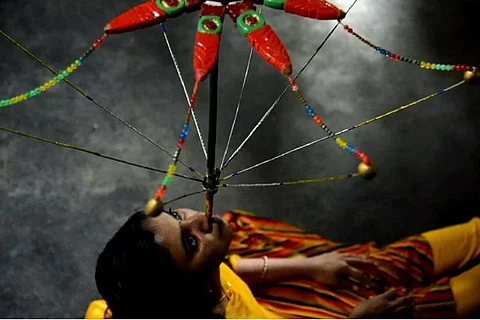This Malayalam documentary is about a little-known puppetry form performed by women
At the Monipally junction in Kottayam, no one she asked knew where Pankajakshi Amma lived. Reshmi Radhakrishnan didn’t expect that. She had read about Moozhikkal Pankajakshi, one of the last practitioners of a dying art form of puppetry, and come in search of the artiste. Reshmi was surprised that neither she, nor anyone she asked, had heard about the art or the artiste for so long. Curiosity took Reshmi – a freelance journalist – on that trip to Monipally to meet Pankajakshi and write her story.
The art form – called Nokkuvidya – has a woman sitting on the ground with a stick holding puppets balanced in the space between the nose and upper lip. Reshmi was so awed that she didn’t stop with the newspaper story. She made a documentary – Nokkuvidya, The life of a lone string puppeteer. It was screened at the International Documentary and Short Film Festival of Kerala (IDSFFK), which concluded on Tuesday, December 14.
“I came across the art form quite accidentally in a history journal. When I researched more, I could not find any videos or more documentation,” Reshmi tells TNM.
The day she first went to Pankajakshi’s house, the artiste – then in her late 70s – pulled out a box from under her bed. Inside it were old dolls – puppets – that she used to balance on her face and perform. But by then Pankajakshi had gotten unwell and too old to perform. Desperate, Reshmi hunted for old videos and found one of Pankajakshi performing Nokkuvidya in a venue in Paris.
“As she got older, she was very worried that she could not pass on the techniques to anyone in the newer generation. It has been performed only by women who belonged to the Velan community. Frantic to find a follower, she stopped caring what community they may belong to. But finally, her granddaughter Renjini, who had earlier been reluctant, came forward,” Reshmi says.
Pankajakshi Amma and Renjini
Renjini, in the documentary, says how frustrating she had found it as a young child having to sit with the stick for hours, neck aching as she tried to balance it above her lip. At some point though, the girl understood the seriousness of the matter. If she didn’t learn it, the art form itself might perish.
Even then, Renjini could not learn all the aspects. “The grandmother used to perform with her hands and legs (twirling props between fingers and toes) even as she balanced the puppets above her upper lip, with her face looking upward. By the time Renjini began picking up the technique, Pankajakshi got older and unwell, unable to teach her more,” Reshmi says.
In the documentary, Venu, Koodiyattam exponent who founded Natana Kairali – a performing arts centre for rejuvenating traditional art forms – speaks about discovering Nokkuvidya. Years ago, they put out a notice calling performers of all forms of puppetry, so they could save any declining ones. Pankajakshmi’s family too turned up. That’s how they learnt about Nokkuvidya. Venu suggested including it in the national puppetry festival. He convinced the organisers who were at first unsure if it could be counted as a form of puppetry. Venu also gave the name ‘Nokkuvidya’. The performers had simply called it ‘paavakali’ or ‘paavakoothu’, not differentiating it from other forms of puppetry.
It is also remarkable that the art form has been traditionally performed by women when all other forms of puppetry were performed by men. “Here, men go as accompanists to the women performers. They sing in the background,” Reshmi says.
Reshmi Radhakrishnan
The songs that Pankajakshi performed to were written by her late husband, Sivarama Panicker. Now Renjini too performs to the same songs.
In a half-hour performance, the artiste tells many stories by replacing puppets every few minutes.
Renjini’s male relatives now do the duties of singing in the background and offering other help. “She has just finished her graduation this year and is looking for a job. But she is very serious about pursuing the art form and is looking for a student whom she can train,” Reshmi adds.

